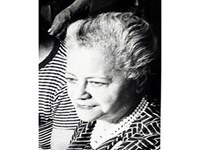- Frederick Douglass National Historic Site (28)
- Boston African American National Historic Site (23)
- Women's Rights National Historical Park (18)
- Belmont-Paul Women's Equality National Monument (13)
- Reconstruction Era National Historical Park (12)
- Boston National Historical Park (10)
- Mary McLeod Bethune Council House National Historic Site (8)
- National Capital Parks-East (8)
- National Mall and Memorial Parks (6)
- Show More ...
Showing 113 results for FRDO ...
Anna Arnold Hedgeman (1899-1990)
- Type: Person

Before Shirley Graham married W.E.B. Du Bois in 1951, she had earned a national reputation as a playwright, composer, conductor, director, and author. Born to a A.M.E. minister and a European mother, Graham was raised to appreciate Black culture and music. From a young age, her parents instilled in her the importance of social justice and the uplift of the Black Community. For her lifelong dedication, we honor her as an ancestor.
- Type: Person

There are people who give great speeches, and they there are those who perform them. Hallie Quinn Brown was one of the few who perform speeches. In her era, she was recognized as one of the greatest elocutionists across two continents, Europe and America. Though she rarely appears in history books, Brown’s legacy can be found in today’s speech-language pathologists and spoken word artists. She lectured widely on the cause of temperance, women’s suffrage, and civil rights. We
- Type: Place

One of the oldest public parks in Washington, D.C, the land was designated as a public park on the original 1791 L'Enfant plan for the city. During the Civil War, a temporary hospital, known as "Lincoln Hospital" was constructed on the site for wounded Union soldiers. Following the war, the army removed the hospital and Congress appropriated funds to improve the park with flowers, trees and pathways. Then as now, it remains one of the most popular city parks on Capitol Hill
Fannie Barrier Williams
- Type: Person

As a member of the National League of Colored Women, Illinois Woman’s Alliance, Women’s Christian Temperance Union, and other women-led organizations, Fannie Barrier Williams laid the groundwork for women’s civic participation in the late 1800s. She used her talents of speaking and writing to pursue activism for the Black women’s rights movement of her time.
- Type: Article

Signed into law July 2, 1964, the Civil Rights Act of 1964 outlawed discrimination on the basis of race, color, religion, sex, or national origin. Many national parks were created to preserve and tell the story of the struggle for civil and human rights leading up to the Act and beyond as we continue to work towards realizing the dream for all people.
- Type: Article

These articles were originally published by the Women’s Suffrage Centennial Commission (WSCC) as a part of the WSCC blog, The Suff Buffs. The Women's Suffrage Centennial Commission was created by Congress to commemorate 100 years of the 19th Amendment throughout 2020 and to ensure the untold stories of women’s battle for the ballot continue to inspire Americans for the next 100 years. In collaboration with the WSCC, the NPS is the forever home of these articles
Paul Laurence Dunbar High School
The Little Rock Nine
Amy Araujo
- Type: Article

Amy Araujo, the first Artist-in-Residence at New Bedford Whaling National Historical Park in 2017, explored themes of identity through large-scale figurative drawings. Her residency honored the bicentennial of Frederick Douglass, featuring free figure drawing classes with fully clothed models and a public art workshop. Araujo’s work connected art and history, inspiring visitors to reflect on freedom, struggle, and resilience.
Henry Ingersoll Bowditch
- Type: Article

Although the abolition of slavery emerged as a dominant objective of the Union war effort, most Northerners embraced abolition as a practical measure rather than a moral cause. The war resolved legally and constitutionally the single most important moral question that afflicted the nascent republic, an issue that prevented the country from coalescing around a shared vision of freedom, equality, morality, and nationhood.
- Type: Person

Dr. Carter G. Woodson was an American historian who first opened the long-neglected field of African and African American History to scholars and popularized the field in schools and colleges across the United States. In 1915, he established the Association for the Study of Negro Life and History, Inc. and in 1926, he created "Negro History Week," which later became "Black History Month."
Lorenzo G. Chase
- Type: Person
A member of the Boston Vigilance Committee, Chase contributed to the larger abolition movement through his work as a daguerreotypist.
Joseph Allyne
- Type: Person
Joseph Allyne support the abolitionist movement through his contributions to and participation in the Massachusetts Anti-Slavery Society, the Boston Free Soil Club, and the Boston Vigilance Committee of 1850.









